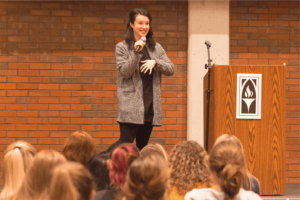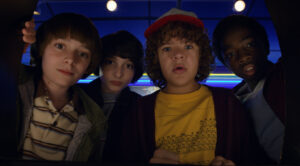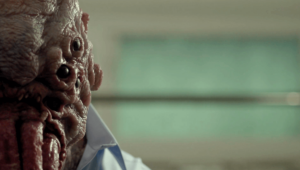Tag: Patrick Fuller ’21
Hannah Brencher: The World Needs More Love Letters
by The Cowl Editor on November 10, 2017
Arts & Entertainment

by Patrick Fuller ’21
A&E Staff
“What is it that makes someone suffer to provide someone else with a better life?” This is the question Hannah Brencher posed to a group of Providence College students in ’64 Hall on Nov. 1 during Mental Health Week.
Brencher, a writer, TED speaker, and communications expert, came to PC to promote her organization “The World Needs More Love Letters,” founded in 2011.
Seeking to “make love famous” by providing strangers with messages of hope and encouragement, the organization includes a global community of 20,000 individuals across six continents, 53 countries, all 50 states, and 73 college campuses.
After graduating from Assumption College in 2010 with a double major in sociology and English, Brencher joined the United Natsions. During her time with the UN, Brencher worked on issues surrounding human trafficking and girls’ education.
Though this work was fulfilling, Brencher mentioned feeling sad and lonely, noting that, “The best parts of [her] life have not come from [her] five-year plan.” Then, she cited a pivotal movement in her life, one which created the theme of this talk. Joe, a 77-year-old math junkie, walked into a Starbucks where Brencher sat doing work and asked, “What do you love?”
Brencher replied, “I love words. If there were a way to bring a semi-colon to prom I would have.” Then, Joe slid her a math problem across the table. Brencher could not solve it, she said to Joe, “I don’t know.” He said that it was not that Brencher did not know, but that she did not know yet. From this event, Brencher reminded us to “Stay hungry. Take note of what wakes you up inside.”
Nevertheless, Brencher attributes the creation of her organization to the example and personality of her mother, a socialite who constantly reminds her to pay attention to the people around her. In a world bouncing between the temporary pleasures of social media and the “stories of people you want to be like,” Brencher’s mother taught her to make every person she encounters feel like the center of the universe.
For this reason, Brencher wrote a letter to a lonely woman on the New York subway. Although the woman got off the train before Bencher had the opportunity to give it to her, she still decided to leave love letters in coffee shops, stores, and delegate seats throughout New York City, all intended for strangers.
Afterwards, she posted on her blog offering anyone who needed hope and love an opportunity to receive a love letter. Expecting five or six requests at the most, Brencher was stunned when hundreds of requests poured in. Eventually, The Wall Street Journal contacted her, turning her humble quest to deliver love into a nationwide movement and a widespread reality.
Therefore, she had to cope with the drastic expansion of her letter writing. Reflecting, Brencher advised anyone seeking to start something new to “just start, figure out the rest later, ask for help, don’t look for perfectionism, and vow to do everything you can.” Through the assistance of a favorite author and interviews with several known reporters, Brencher created The World Needs More Love Letters, and wrote her first book, If You Find This Letter. Now, the organization has delivered over 125,000 letters to people around the world, comforting widows, giving appreciation to veterans, and sending hope to cancer patients.
From her experiences, Brencher reminded the audience to do “small things on repeat.” She remembered getting 300 girls to wish her friend a happy birthday after he suffered a terrible heartbreak. The reaction from her friend showed the effectiveness of a simple gesture. After all, according to Brencher, “It is easy to go through these four years and ask, ‘What can I get?’ It’s pretty cool to ask, ‘What can I give?’”
Finally, Brencher told the audience to “stay here.” Apparently, Brencher’s driver for her 2015 Barnes and Noble book launch was the driver in The Devil Wears Prada. However, without the inquiry of her outgoing mother, Brencher would never have discovered this fact, being a diehard fan of the film. As Brencher told her audience, “Investing in someone’s life is different than investigating someone’s life.”
Closing out her conversation, Brencher made sure to circle the lecture back to mental health. She reminded everyone that “it’s okay to not be okay,” and to “be those lighthouses for people.” Yet, most of all, Brencher wants us all to be buffalo. Like her old physical trainer once remarked, buffalo do not hide from a storm but run towards it.
Weezer’s New Album Pacific Daydream: Weezer Brings the Beach Back to Fall
by The Cowl Editor on November 2, 2017
Arts & Entertainment

by Patrick Fuller ’21
A&E Staff
Fall has very quickly taken New England captive with its awkwardly cold temperatures, vibrant leaves, and flannel stereotypes. Even in the intangible world of music, artists have been putting out records suited for casual hangout sessions rather than mass parties in the open air. However, with the return of punk-grunge band Weezer comes the return of summer.
In contrast with the hip-hop scene, Weezer sticks with its rock roots, targeting the ostracized high school geek in the band’s new album Pacific Daydream, released on Oct. 27.
As The New York Times mentions, the band is part of the “…rear-guard of the era when rock dominated pop, looking back fondly and analytically to dense psychedelic studiocraft and ignoring an era of blunt spoken-word catchphrases and programmed, stripped-down, earbud-ready MP3 tracks.” Thus, the album is filled with nostalgia, alluding to boy bands of old in “Beach Boys” and utilizing catchy, melodic choruses in “Feels Like Summer.”
However, the album is influenced by many more artists of the 1960s and 1970s, such as The Zombies, George Harrison, and Ted Rundgren.
Nevertheless, Weezer has undoubtedly surrendered to the trends of the modern musical era, using sped-up samples like Kanye West and working with producer Butch Walker, known for producing for big names like Taylor Swift, Katy Perry, and P!nk. His experience helps bring Weezer into the virtual pop scene with loops, arrangements, and programmed beats.
Rolling Stone gave the album 3 out of 5 stars, and noted their lead singer Rivers Cuomo intended for the band’s 11th studio album to be named The Black Album as a dark contrast to last summer’s LP The White Album. However, the writing process resulted in a theme of positivity.
On top of writing lyrics, Cuomo is the unchallenged genius behind the technical elements of the album, combining various riffs, chord progressions, and beats all in a Google Sheets program.
This combination of evoking loneliness and reflection through lyrics and musical discipline brings songs like “Get Right” and “Sweet Mary” to life. However, Rolling Stone calls the album “a little too overworked,” commenting, “Pacific Daydream’s edges are a little too smooth, its imperfections non-existent.” After all, the trademark of punk-grunge bands is a gritty rawness easily transferrable to live performances.
On the other hand, Newsday claims, “The band’s skills and ambitions lead to an impressive set of California-dreaming songs,” praising the atypical hip-hop grooves and ’80s R&B vibes present in Weezer’s newest album.
According to The Los Angeles Times, even Cuomo agrees, “To me this is the most different-sounding Weezer record ever. I’m so excited because we finally broke away from the downstroke eighth-note power-chord thing.”
Throughout the next couple of months, Weezer will be touring Europe, Australia, New Zealand, and the west coast of the United States. Without a doubt, Cuomo will pass over the Northeast on the Pacific Daydream tour since he is a born and raised New Englander.
Strange(r) Things are Happening: You Better Boo-lieve You Are in For a Frightening Season
by The Cowl Editor on October 26, 2017
Arts & Entertainment

by Patrick Fuller ’21
A&E Staff
When we enter our late teens, the biggest question of our life blindsides us like an inter-dimensional monster snatching up innocent children: what do we do after we are too old to wear costumes and go trick-or-treating? Well, Netflix has the perfect answer. On Oct. 27, the Friday before Halloween, Netflix is set to release the second season of the sci-fi horror series, Stranger Things. Several trailers promise a season filled with further exploration of the Upside Down, an alternate universe accessible via portal in the Hawkins National Laboratory.
Now the fall of 1984, the original cast of kids (Eleven, Mike, Lucas, Will, and Dustin) team up with some new faces to discover the supernatural forces affecting the town of Hawkins. According to executive producer of the show, Shawn Levy, “There’s definitely a handful of really compelling new characters this season, but absolutely servicing the core group first and foremost. Like the show itself, it is multigenerational new characters and really, really intriguing ones.”
Those new characters includes Max (Sadie Sink), a “tough and confident 13-year-old female” with a difficult relationship with her stepbrother, Billy. Billy is a “super muscular, overconfident 17-year-old” who “steals peoples’ girlfriends, is a drinking game pro, and drives a black Camaro.”
Entertainment Weekly reported that a character named Roman is, “an emotionally damaged, magnetic young woman who suffered a great loss as a child.” Apparently, she has a connection with the unusual events occurring at the Hawkins National Laboratory.
Twin brothers Matt and Ross Duffer, who created the show, directed and wrote the first and last two episodes of the nine-episode season, allowing for other people like Levy and Andrew Stanton to contribute. The two siblings reflected, “The [sequels] we look up to aspire to pivot and do something different,” citing Stephen Spielberg’s Indiana Jones and the Temple of Doom as well as James Cameron’s Aliens and Terminator 2. Meanwhile, season one veteran writers Justin Doble and Jessie Nickson-Lopez wrote one and two episodes respectively.
Furthermore, some of the cast has revealed minor spoilers for season two. During a panel at New York Comic Con, David Harbor, who plays Chief Jim Hopper of the Hawkins police department, insinuated that season two might delve deeper into the death of his daughter, Sarah.
Furthermore, he mentioned that the love triangle between Nancy, Steve, and Jonathan will continue. At the same time, Chief Hopper will attempt to keep the past year’s events covered up in order to protect the kids and Joyce Byers, Will’s mother.
Meanwhile, Max will befriend the boys and attract the interest of Dustin and Lucas. Additionally, Dustin will bond with a polliwog-like creature that is not from this planet or this dimension. Overall, Matt Duffer teased that Eleven would once again play a major part in season two, saying, “We do get into her story and backstory. We learn about where she came from and how she came into the world and the program that resulted in her.”
Surely such a show about monsters and love, written and directed by seasoned veterans and featuring an experienced cast, has the potential to replace Halloween traditions. In fact, binging Stranger Things on Netflix could be a Halloween custom for the next couple of years, as the Duffer Brothers have confirmed at least another two seasons. Until then, snuggle up with some candy corn and enjoy season two of Stranger Things.
All ‘Viled’ Up: Courtney Barnett and Kurt Vile team up for new album Lotta Sea Lice
by The Cowl Editor on October 19, 2017
Arts & Entertainment

by Patrick Fuller ’21
A&E Staff
Collaboration has been a common theme in the music industry in 2017. In recent times, Lana Del Rey whipped up Lust for Life featuring artists like Stevie Nicks and Sean Lennon, while The Weeknd produced Starboy featuring Daft Punk, Future, and Kendrick Lamar.
It is easy to see that most of the popular, modern collaborations appear solely in the genres of rap or pop. However, that mold has been broken by the collaborative album Lotta Sea Lice by Kurt Vile and Courtney Barnett.
To the general public, these names may seem insignificant. In the world of mainstream music, alternative rock takes a back seat to the high energy of pop and rap. Yet, Vile and Barnett are two of the most talented, traditional rock stars dominating the alternative scene right now.
Before the collaborative album, Vile gained fame through working as the lead guitarist for the band The War on Drugs and pursuing a solo career with his backing band, Violators. Combining influences like Neil Young and Tom Petty, Vile creates music that is both instrumentally brilliant and vocally unique. With a little help from the song “Pretty Pimpin,” his 2015 album, b’lieve i’m goin down… peaked at number 40 on the Billboard 200.
Meanwhile, Barnett is an Australian guitarist and singer known for her monotone sound and outlandish lyrics. Rising to fame in 2013 with the album The Double EP: A Sea of Split Peas, Barnett gradually evolved her individual sound to form her acclaimed 2015 album, Sometimes I Sit and Think, and Sometimes I Just Sit.
This masterpiece granted Barnett four awards from eight nominations at the 2015 ARIA Music Awards as well as nominations for Best New Artist at the 58th Annual Grammy Awards and International Female Solo Artist at the 2016 Brit Awards.
All being said, Lotta Sea Lice is a combination of the two artists’ styles. Whacky song titles like “Blue Cheese” harken back to the goofiness of Barnett’s solo lyrics. At the same time, complicated guitar work alludes to the instrumental proficiency held by both artists.
Over the top of the entire album, the nasally tone of Vile’s voice grounds Barnett’s accented pitch into a seamless, relaxing conversation held during “Continental Breakfast.”
As Rolling Stone mentions, “As collaborators, they’re a perfect match: Kurt Vile is a master of zoned-out fingerpicking and droll longhaired jive; Courtney Barnett is a Dylanesque image ninja who can turn everyday stuff like making ramen noodles into rich, personal meditations.”
While the album is undoubtedly tamer than each artist’s catalogue, the record brings a nice change of pace to the alternative rock sphere, revealing the eclectic capabilities of Vile and Barnett.
Summarizing the general consensus, Pitchfork gives Lotta Sea Lice a 7.6 out of 10, calling the album, “…an intimate, fly-on-the-wall perspective on two peers talking shop about their songwriting methods.”
With a relationship producing such approval, this might not be the last we see of Vile and Barnett. The duo will be playing next at the Orpheum Theater in Boston on Nov. 4.
Cthulhu On Campus: Providence College Alumni Screen Short Film
by The Cowl Editor on October 5, 2017
Arts & Entertainment

by Patrick Fuller ’21
A&E Staff
Two Providence College alumni walk into a bar. No, this scenario is not a setup for a joke. However, this situation is the birthplace of the short film The Call of Charlie, a kind of largescale joke in its own right. Director Nick Spooner, used to working with commercials, noted that “alcohol was involved,” in the creation of this far-fetched idea.
As Spooner answered questions from the front of the Guzman lecture hall on Sept. 28, writers Guy Benoit ’91 and John Simpson ’85 nodded in agreement. The Providence College Department of English, Department of Theatre, Dance, and Film, and the Alumni Association invited the creators of The Call of Charlie onto campus to show their horror-comedy creation to students. The Call of Charlie displays what happens when you set someone up on a blind date with Cthulhu. Cthulhu is the ancient, octopus-faced monster worshipped by cultists in the short story “The Call of Cthulhu,” written by H.P. Lovecraft.
As one might expect, bringing this fictional creature to life was no small feat. Spooner mentioned struggling to find a means to create the mask of Cthulhu out of a sketch he made himself. Eventually, he stumbled upon some ambitious teenagers at Basement FX, a silicon mask manufacturing company in Wisconsin, who were willing to make Spooner’s vision come true.
Special effects alone made up a lot of the film’s charm in that everyone was equally confused as to how Cthulhu was blinking, moving its tentacles, and making strange sounds; a creature from fictional mythology was made eerily realistic. At the same time, the short film managed to elicit both laughter and shock as characters interacted with each other at a casual dinner party. All of this emotion was consolidated into a mere 15 minute screenplay.
To think this whole piece came about in such a short time is amazing. Benoit estimated, “From the gag at the bar to the shooting…about three months went by.” In this time, there was no cutting corners. The crew hired a strong cast consisting of Brooke Smith from The Silence of the Lambs and Roberta Valderrama from The Purge: Anarchy. At one point, they even had Marilyn Manson lined up for a minor part as Spooner thought, “It would be really funny to get someone big to play a really insignificant role.”
The short film succeeded. In 2016, the year the film debuted, the team won the Audience Award at the H.P. Lovecraft Film Festival in Portland, Oregon and was nominated for the Best Screenplay Short at the Nightmares Film Festival. The following year, the cast and crew won the Best New England Film at the Boston Underground Film Festival, Best Effects in a Short Film at the Horrible Imaginings Film Festival, and was nominated for Best Horror Short at the Cape Fear Independent Film Festival.
These accolades make up a small portion of 21 wins or distinctions and 66 festival selections. Independent bloggers, such as Joseph Perry of the horror movie site Gruesome Magazine, rave about this film calling it “a wry, sly horror comedy that satirizes social affectations.” The story of the bachelor Cthulhu, however, may end here. Spooner, Benoit, and Simpson denied a sequel, but followed up with a hopeful spoiler: although they will not make a sequel, they have “two different suburban horror features in the works.”
“PC’s Got the Funk”: An Interview with History of Jazz Professor, Alex Lee-Clark
by The Cowl Editor on September 28, 2017
Arts & Entertainment

by Patrick Fuller ’21
A&E Staff
Recently, I sat down with Alex Lee-Clark, a new history of jazz professor at Providence College, to ask him a couple questions about his current projects. Although he teaches trumpet and directs the Funk Ensemble, his influence and expertise extends beyond the PC campus.
Aside from teaching at PC, he runs “Pop Up Music,” an organization that “uses live music and discussion to engage your team in the creative act of listening: the art of listening to yourself and others, of hearing the meaning behind music, and of creating cohesion and understanding,” according to the musician’s website.
Furthermore, Lee-Clark heads two bands: the ALC Funktet and the ALC 8tet, and co-leads the BT/ALC Big Band with Brian Thomas.
PF: Could you give a brief run-down pertaining to the type of material students learn in The History of Jazz course?
ALC: I would say I have two goals. I want to give a quality overview of the history of jazz and why it’s important, but also focus on who the important people are. I think these are American geniuses. They’ve so completely shaped music today. But the other part about the course is that I want to teach people to listen actively to jazz and, subsequently, to other music. I want this to be a thing where I create (diabolically) a legion of music listeners who, when they go to a concert or listen to their own music, they think with a larger percentage of their minds. Subsequently, I want to cultivate concert-goers.
PF: Why do you think it is important for students to learn about the history of jazz?
ALC: I think that the history of jazz is the history of popular music and the history of how we treat musicians now. Jazz is so deeply embedded in American culture that we don’t even think about it. I think that, if you’re a better listener to jazz, then you’re a better listener to the world. There’s no lyric to tell you what to feel. What you have to listen for is the intention that’s being expressed. Especially in the charged political climate of today, we don’t listen in a constructive manner. Not only listening, but waiting for your time to talk, is an important skill for humans.
PF: I know you yourself are in a handful of bands, could you just briefly explain the focus of each one?
ALC: The idea of being in a band is pretty rare. In any given year, I’ll play with like 20 different bands. I’m more of a guy in town. The Funktet is a collective, it’s five musicians I happen to play with that night. They could be anybody. The BT/ALC Band is a band with set members. That’s basically my main project. We play funk but we also follow the style of jazz in the sense that jazz is a verb. You decide what the rules are, and then you improvise. The 8tet is my more straight-ahead jazz outlet. That band is more of my personal laboratory.
PF: You also run an organization called “Pop Up Music.” How did this organization come to be, and do you have any memorable experiences with certain startups?
ALC: My business partner and friend Ben Whiting graduated from Berklee and started touring, playing weddings, etc. But he wasn’t happy, he didn’t enjoy it. Ben started working at this place called the Cambridge Innovation Center (CIC), which harbors start-ups of all different sizes. In that, he expanded his network and started inviting people to shows, which were very well received. Eventually, we did a concert at the Cambridge Innovation Center as a sort of talk/lecture hybrid. Surprisingly, people stayed, people bonded, which we weren’t used to. As for notable companies, they include the CIC and Mass Challenge, but we are always looking for more clients and more opportunities.
PF: What have been your top three musical influences as a trumpet player?
ALC: It’s hard to say because you really cherry-pick from everybody but definitely Miles Davis, Clifford Brown, and some classical composers. My other biggest trumpet influences are my teachers: Kim Dunnick from Ithaca College, Eric Berlin from UMass, and my composing teacher, Jeff Holmes.
PF: Finally, do you have anything to say that might convince students to take this course?
ALC: I would tell people to take the course because you learn a flavor of what was relevant in jazz’s day. The course to me is about the experience of listening and the experience of getting more out of the music you listen to now. It makes listening to music richer. It makes you hear with different ears and see with different eyes.
